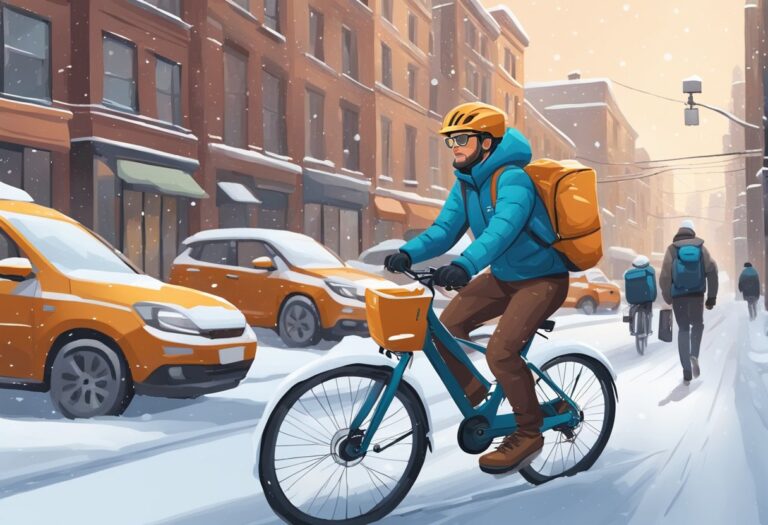Essential E-Bike Gear for Winter Urban Cyclists
As winter approaches, city commuters and cycling enthusiasts often look for ways to adapt their electric bikes for colder conditions.
Riding an electric bike in winter poses unique challenges, from slippery roads to reduced battery performance in low temperatures.
However, with the right equipment, e-bike riders can overcome these hurdles, ensuring comfort, safety, and reliability.
Innovative e-bike accessories designed for winter riding are becoming increasingly popular, helping to transform the biking experience during the colder months.
Essential accessories for winter riding range from season-specific tires offering enhanced grip on icy surfaces to advanced lighting systems that provide visibility during shorter daylight hours.
For instance, investing in tires that can work on tricky road surfaces is a wise choice.
Moreover, the selection extends to thermal covers that protect battery life and high-quality clothing designed for warmth and weather-resistance, without compromising on mobility.
Beyond the basics, there are also non-essential yet highly beneficial accessories to consider for an electric bike.
These include heated grips that keep the hands warm and responsive or Bluetooth-enabled devices that offer navigation and ride tracking, even on the coldest days.
By coupling these innovations with an electric bike’s inherent efficiency and ease of use, winter riding in the city becomes not just bearable, but also enjoyable.
Table of Contents
Essential E-Bike Accessories for Winter
High-Traction Tires
For winter e-biking, high-traction tires are indispensable. These tires, particularly studded or fat tires, provide the necessary grip to prevent slipping on ice or snow.
Winter-specific tires like the Schwalbe Marathon Winter Plus come with built-in studs that bite into ice, offering stability and peace of mind.
Advanced Lighting for Visibility
Shorter days and longer nights demand advanced lighting systems for e-bikes. Lights increase visibility not only for the rider but also for other road users.
Bright, durable front and rear lights are key accessories, ensuring one is visible even during the lowest light conditions of winter.
Robust Fenders for Wet Conditions
Muddy splashes and road grit are common in wet conditions, making robust fenders a crucial addition to any winter e-bike setup. They protect both the rider and the e-bike’s components from debris and water, ensuring a cleaner and drier ride.

Handlebar Pogies and Bar Mitts
Handlebar pogies and bar mitts offer a protective enclosure around the controls, keeping hands warm and controlling grip reliable. These accessories eliminate the need for bulky gloves, making it easier to maneuver the e-bike and access brake levers and gear shifters.
E-Bike Specific Winter Helmets
Lastly, a winter helmet designed for e-biking offers enhanced safety and warmth. Look for helmets with fewer ventilation holes, and possibly insulation, to retain heat while safeguarding the head during rides in the cold.
Battery and Electrical System Care
Proper care of the battery and electrical system is crucial for ensuring optimal e-bike performance during winter city rides. Attention to these details maintains battery life and ensures the drive system operates efficiently in colder temperatures.
Optimizing Battery Life and Performance
To maximize battery life and performance, riders should store their electric bike’s battery at room temperature, ideally between 50-77°F (10-25°C). Batteries should not be charged at or below freezing temperatures.

It is advisable to bring the battery to room temperature before charging, a process that might take a few hours after bringing it inside from the cold. Maintaining an optimal charge level also aids longevity—usually between 30% and 60% if storing the bike for an extended period without use.
- Best Practice for Battery Storage and Charging:
- Storage Temperature: 50-77°F (10-25°C)
- Charging: Only at room temperature
- Optimal Charge Level for Storage: 30% – 60%
For an electric bike’s torque to be delivered effectively, the battery should be fully operational; hence, proper charging is not just about longevity but performance on the ride as well.
Careful charging can lead to a reliably powered e-bike ride in winter conditions.
Cleaning and Maintenance for Electronic Components
Regular cleaning and maintenance of an e-bike’s electrical components are essential for uninterrupted performance.
One should clean the battery contacts and electrical connections with a dry cloth to remove any dirt or grime. Avoid directly spraying water or using high-pressure hoses on electric parts to prevent moisture penetration which could lead to electrical failures.
- Cleaning Checklist:
- Battery contacts: Clean with a dry cloth.
- Electrical connections: Check and clean regularly.
Moreover, schedule inspections of the e-bike’s drive system to ensure that all electronic components function appropriately.
Simple maintenance steps like these can prevent issues that may otherwise go unnoticed until they impact the e-bike’s performance.
Regular maintenance ensures every e-bike ride remains safe and efficient, even in winter’s demanding conditions.
Comfort and Protection Against the Cold
When riding an e-bike in winter conditions in the city, staying warm and dry is crucial for comfort and safety. This section focuses on the specific gear that will help maintain a favorable temperature and protect against the cold weather elements.
Layered Winter Clothing
Layered clothing is essential to trap body heat and provide flexibility based on changing temperatures. A moisture-wicking base layer is critical for staying dry; it should fit snugly to wick sweat away from the skin. Over this, an insulating mid-layer retains warmth.
Finally, a quality winter jacket is indispensable, ideally one that is windproof and breathable.
Hands and Feet Warmth Solutions
Keeping extremities warm can be the difference between an enjoyable ride and a miserable one. Here are the best options:
| Hands | Feet |
|---|---|
| Insulated gloves | Thermal socks |
| Heated glove liners | Insulated boots |
Good circulation helps too, so gloves and socks shouldn’t be too tight. Hand and feet warmers are additional options for riders who face extremely low temperatures.
Waterproof and Insulated Gear
Amidst winter city riding, it’s not just the cold that’s an issue. Wet conditions require waterproof gear:
- Waterproof jacket and pants keep rain and snow out.
- Additional accessories like a scarf and waterproof gloves further prevent heat loss.
- Insulated gear comes in layers, like a full sleeve jersey beneath a jacket, providing added warmth.
It’s important for comfort that these items are breathable to prevent overheating and accumulation of moisture inside.
Safe Commuting in Winter Conditions

When commuting through urban winter landscapes, the essentials for safety revolve around enhanced visibility, reliable navigation, and secure stopping points. These elements are vital to ensure that both the rider and their e-bike remain safe amongst other road users, and from the challenges posed by snow and ice.
Navigational Accessories and Planning
In winter commuting, navigation is not just about finding the quickest route, it’s about finding the safest one. Riders should outfit their e-bikes with advanced navigational tools such as GPS tracking to make real-time decisions based on road conditions. The following is a list of navigational accessories that bolster safety for winter commuting:
- GPS Device: To assist with route planning and to avoid hazardous areas.
- Interactive Map Applications: Provide guidance for ice-free and well-lit paths.
Secure Locking Mechanisms for Stops
Securing an e-bike during brief stops in winter requires robust locking mechanisms to prevent theft or tampering, which could comprise safety. The ideal bike lock should offer both convenience and high security in winter conditions—when metal can freeze and mechanisms can seize. U-locks and folding locks are preferred for their durability and resistance to tampering. However, for added security, one might consider using a cable lock in conjunction with a U-lock. Here is a simplified selection guide for choosing the right lock:
| Lock Type | Advantages | Winter Consideration |
|---|---|---|
| U-Lock | High security level, resistant to leverage attacks | Can freeze; use anti-freeze lubricant |
| Folding Lock | Flexible, compact, and easy to carry | Hinges require regular maintenance |
| Cable Lock | Good for accessory security, flexible | Less secure; best as a secondary lock |
In addition to physical locks, riders should consider e-bikes with inherent security features such as built-in alarms or movement sensors that notify the owner if the bike is being tampered with. For the urban commuter, these security measures are essential in maintaining the integrity and safety of their ride throughout the winter season.
E-Bike Winter Riding Techniques
To safely ride an e-bike in winter conditions, it’s necessary to adjust your approach to riding and maintaining your bike. Winter riding demands attention to both technique and bike condition to ensure safety and performance on snowy and icy city streets.
Adjusting Riding Style for Winter Terrain
When navigating winter roads, stability and traction are paramount. It’s advisable to reduce speed and apply force to the pedals steadily to avoid slipping. On snow or ice, sudden movements can lead to loss of traction. Therefore, riders should anticipate stops and turns well in advance and use a light touch when applying the brakes to maintain control.
Proper Tire Pressure and Chain Maintenance
Maintaining the right tire pressure is critical for balance and grip in winter conditions. Lowering pressure slightly can provide a larger contact area between the tire and the road, enhancing traction. However, tire pressure should not be so low as to risk tire damage or rim contact.
| Terrain Type | Recommended Tire Pressure | Reason |
|---|---|---|
| Snowy Surfaces | Slightly Lower | To increase tire footprint and improve grip. |
| Icy Conditions | Moderate | To maintain stability without losing traction. |
Regular chain maintenance is also essential to ensure smooth operation and to prevent malfunctions due to rust or debris. Cleaning and lubricating the chain helps maintain bike efficiency and reduce wear from salt and grit.
Using the right tools, such as tire levers and a reliable floor pump, simplifies the adjustment of tire pressure and helps prevent tire damage during maintenance, thus keeping your e-bike in top condition throughout the winter months.
Additional Convenience Features and Accessories

Riding an e-bike in the city during winter demands accessories that combine utility with protection against the elements. City riders need solutions for carrying goods, improving visibility, and handling minor repairs under winter conditions.
Practical Storage Options
For city e-bikers, practical storage options are imperative. Racks and saddle bags provide convenient spaces for personal items and shopping goods. E-bike specific designs are tailored to fit without impacting the performance of the bike. Some have built-in covers to protect contents from snow and rain, which is particularly useful in winter conditions.
- Saddle Bags: Easy to attach and detach; available in waterproof materials.
- Front and Rear Racks: Great for heavier loads; some come with spring clamps for added security.
Visibility and Safety Enhancements
Maintaining visibility is crucial for safe winter riding. Lights are mandatory as daylight hours are shorter, and reflective clothing or accessories ensure the rider remains visible to others. Mirrors can be added for better awareness of the surroundings.
- Front and Rear Lights: Should be bright and have multiple modes for different times of day and weather conditions.
- Reflective Gear: Jackets, helmets, or straps enhance visibility.
Convenient Tool Access for Repairs on the Go
City riders encounter unexpected issues, and having a pump and basic repair tools easily accessible can be a saving grace. Mounts on the bike frame allow for tools like a pump or phone mount to be stored efficiently and within arm’s reach. Quick access to tools means less downtime and more time enjoying the ride.
- Pump Mount: Typically located under the water bottle cage; should be lightweight yet robust.
- Phone Mount: Vital for navigation; opt for one that secures the phone against vibrations.
Tips for Enhancing Overall E-Bike Experience
To navigate the winter cityscape with ease, ensuring your e-bike is optimized for range and performance is crucial. Heated grips and lights are fundamental, while fat tires can help negotiate slippery streets.
Maximizing Range and Performance
Battery Care: Store the battery in a warm place before your ride, as cold temperatures can reduce battery efficiency and thus range.
Tire Selection: Choose fat tires or wider tires for better traction in snowy conditions, which contributes to safer and more efficient riding. Here’s a snapshot of why tire choices matter:
| Tire Type | Benefits |
|---|---|
| Fat Tires | Improved grip on snow; stability |
| Wider Tires | Better surface contact; comfort |
Regular Maintenance: Keep the bike’s chain clean and lubricated to minimize energy loss. Regularly check the tire pressure, adjusting for colder temperatures to maintain optimal performance.
Weight Reduction: Remove any unnecessary accessories to lighten the load, enhancing the bike’s range and responsiveness.
By focusing on these specific areas, city riders can enhance their electric bikes for a superior winter riding experience, blending comfort with reliable performance.
Winter Riding Considerations for Electric Bike Manufacturers
When temperatures drop, electric bike manufacturers face unique challenges in ensuring their bikes are prepared for winter conditions. Addressing the needs of riders in colder climates is not just about comfort but also about safety and functionality.
Innovative Designs for Winter-Ready E-Bikes
Electric bicycle manufacturers like Biktrix have to consider a variety of factors when designing bikes that are suitable for winter riding in urban environments. The goal is to create e-bikes that maintain performance and safety year-round, including on snow-covered streets or during routine commutes in cold weather.
Tires and Traction: A crucial factor for winter-ready e-bikes is the tire design. Gravel bike tires with wider profiles and more aggressive tread patterns help maintain traction on slippery urban roads.
Battery Performance: Cold temperatures can drastically reduce battery efficiency and range. Manufacturers must insulate and possibly heat batteries to ensure they can operate efficiently in low temperatures.
Frame and Materials: The frame must be crafted to prevent the accumulation of snow and ice, with materials that resist corrosion from winter road salts.
Lighting and Visibility: Reliable lighting systems become even more vital during the shorter daylight hours of winter. Lights should be positioned to remain clear even in snowy conditions.
Controls: Controls and displays should be designed to be easily operated with gloved hands, allowing riders to maintain control without exposing themselves to the cold.
By incorporating these considerations into their designs, electric bicycle manufacturers can enhance the winter riding experience and ensure the safety and satisfaction of their urban cyclists.






Leave a comment